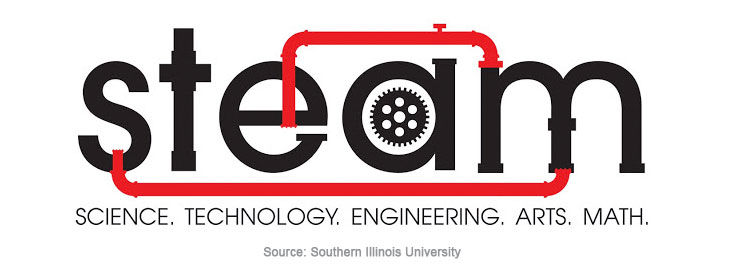
Ruth Catchen has gone from opera singer, to music educator to advocate for the arts in technical education. The Colorado-based consultant has gained national attention for her unique approach to Science, Technology, Engineering and Math—or STEM, as it's commonly called.
Add a dash of creativity to the equation: STEAM + Art = STEAM.
STEAM, she says, is the most logical way to learn.
"It is a way of learning that maximizes the concept of divergent thinking," she explains on education blog MiddleWeb. "We need the arts and our ability to communicate to do anything. As well, we must view things from the eye of a critical thinker, which is one who constantly wants to solve problems or make things work more efficiently."
That makes sense to us. Creativity matched with technical skill, of course, yields innovative results.
A 2014 study by the American Society for Engineering Education noted that STEM education is so successful because the teaching methods are inquiry-based and centered around students. It engages students in solving real-world challenges. It encourages teamwork. It shows how to use mathematics in a meaningful way that students will actually use later in life.
STEM is a specific guideline for integrating and applying math and science to create solutions for real problems. It requires a high level of focus.
In a way, the process already involves art, by requiring students to design products or communicate by writing or speaking about a solution.
Through her pilot STEAM program, Catchen is showing how art can inform her pupils' design, presentation and creative planning.
That doesn't mean her students show how molecules move through interpretive dance, Catchen jokes.
"Instead, it allows different neural pathways (we might call them head and heart) to work in harmony," she wrote. "Although humans cannot use both neural pathways at once, they can process and use critical thinking skills to combine the experiences from both, creating a better outcome."
STEAM lends balance to a rigorous technical curriculum. It inspires the kind of out-of-the-box thinking that takes engineering to the next level.
In a column on the need for more "STEAM power" in American education, Bishop-Wisecarver President Pamela Kan said it's all about balance.
"Innovation requires a creative mind," she wrote, "and what better training ground than the arts to open up the realms of creativity?"
In a conversation with NOVA Education, public school art teacher and Rhode Island School of Design alumna Meghan Reilly Michaud spoke about how the art-science connection has the potential to transform the 21st century economy by inspiring a generation of creative makers. We've posted the clip below.
Add a dash of creativity to the equation: STEAM + Art = STEAM.
STEAM, she says, is the most logical way to learn.
"It is a way of learning that maximizes the concept of divergent thinking," she explains on education blog MiddleWeb. "We need the arts and our ability to communicate to do anything. As well, we must view things from the eye of a critical thinker, which is one who constantly wants to solve problems or make things work more efficiently."
That makes sense to us. Creativity matched with technical skill, of course, yields innovative results.
A 2014 study by the American Society for Engineering Education noted that STEM education is so successful because the teaching methods are inquiry-based and centered around students. It engages students in solving real-world challenges. It encourages teamwork. It shows how to use mathematics in a meaningful way that students will actually use later in life.
STEM is a specific guideline for integrating and applying math and science to create solutions for real problems. It requires a high level of focus.
In a way, the process already involves art, by requiring students to design products or communicate by writing or speaking about a solution.
Through her pilot STEAM program, Catchen is showing how art can inform her pupils' design, presentation and creative planning.
That doesn't mean her students show how molecules move through interpretive dance, Catchen jokes.
"Instead, it allows different neural pathways (we might call them head and heart) to work in harmony," she wrote. "Although humans cannot use both neural pathways at once, they can process and use critical thinking skills to combine the experiences from both, creating a better outcome."
STEAM lends balance to a rigorous technical curriculum. It inspires the kind of out-of-the-box thinking that takes engineering to the next level.
In a column on the need for more "STEAM power" in American education, Bishop-Wisecarver President Pamela Kan said it's all about balance.
"Innovation requires a creative mind," she wrote, "and what better training ground than the arts to open up the realms of creativity?"
In a conversation with NOVA Education, public school art teacher and Rhode Island School of Design alumna Meghan Reilly Michaud spoke about how the art-science connection has the potential to transform the 21st century economy by inspiring a generation of creative makers. We've posted the clip below.

